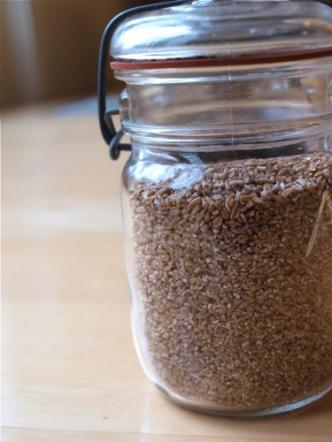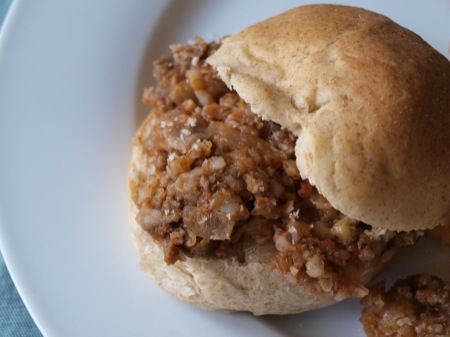Like most people who enjoy spending time in the kitchen, conquering new ingredients is something I live for. Earlier this month I decided that 2012 would be (cue fanfare music) “The Year of New Grains.” Between the growing debate about gluten-free and the emerging research about diets rich in whole grains, I figured now was as good of time as any to add a few into my kitchen repertoire. As of 2011, I could make a mean oatmeal and occasionally my brown rice came out better than Elmer’s glue.
So where does one start on a whole grain adventure? Wikipedia, of course. As it would happen, there are 18 whole grains on the unofficial list. Definitely enough to last me through 2012. Earlier this month I started at the top with bulgur, a grain that’s never made an appearance in my kitchen before.
What’s bulgur? 
Bulgur, by definition is a derivative of wheat that has been partially cooked, dried and bit of the bran taken off. Although bran typically is what defines a whole grain, the USDA considers it whole grain because more than half of the bran is still present and it is low in fat. Bulgur originated in the Mediterranean and is a major grain in Middle Eastern cuisine. Like all whole grains, it is high in fiber and protein. The best part about bulgur is its rich, nutty flavor. It smelled like caramel popcorn when I cooked it.
Where do I find it?
Bulgur can be found at most supermarkets, co-ops, and health food stores. I purchased a 1 pound bag at Kowalski’s in St. Paul for about $5. When buying bulgur, it’s important to look for 100% whole grain bulgur wheat and not cracked wheat. The two are often sold under similar labels, however cracked wheat may not be in the whole grain form.
What do I do with it?
I’m not much of an eat-a-bowl-of-boiled-mush gal, so it was important to find ways to subtly add bulgur to my diet. In many recipes it can easily take the place of rice or couscous. Here’s the easy ways I added bulgur to my meals:
- Bulgur Pilaf- Probably the most common way Americans encounter bulgur. It’s the first way I tried it and one of the easiest dishes I’ve ever made. Cook the bulgur in water or stock. Drain and fluff with a fork. While the bulgur cooks, sauté any 2 cups of available chopped vegetables (Really. It’s an everything but the kitchen sink deal). Add to the cook bulgur with any fresh chopped herbs and toss to evenly mix.
- Bulgur Stuffed Squash- Cut a small squash (acorn works well) in half and bake for 30 minutes. While squash is baking, combine cooked bulgur, green pepper, onion, a diced apple and garlic. Remove squash from oven, stuff with bulgur mix and brush with maple syrup. Return to oven and bake until squash is tender.
- Tabbouleh- A simple Middle Eastern parsley salad that has become a household name in recent years. It uses bulgur that’s been soaked in boiling water or stock combined with tomatoes, fresh mint, olive oil, lemon juice and hefty amounts of fresh green parsley. Variations (of the more than 1 million on Google!) include adding cucumber, scallions or garlic.
- Veggie Fried Bulgur- Instead of rice, try bulgur! Cook 2 cups of bulgur and drain, fluffing with a fork. While bulgur is cooking, sauté 4 cups of mixed garden vegetables (peas, carrots, green onions, etc.) with garlic and fresh ginger. When vegetables are tender, add in bulgur and evenly toss. In the
 Sloppy Joe made with bulgur middle of the pan, create a small well and crack 2 eggs into the center. Cook, stirring occasionally until eggs are set. Add in soy sauce and cayenne pepper to taste.
Sloppy Joe made with bulgur middle of the pan, create a small well and crack 2 eggs into the center. Cook, stirring occasionally until eggs are set. Add in soy sauce and cayenne pepper to taste. - Bulgur Barbecue- Mix 1 cup of cooked bulgur with every 2 cups of fully cooked ground beef. Add in ketchup, maple syrup and your favorite Sloppy Joe seasonings and simmer until flavors blend. It’s an easy way to make expensive grass fed meats extend a bit farther.
- Bulgur Stuffed Mushrooms- Remove stems from 12 large stuffing mushrooms and finely chop. Combine stems with 1 cup of cooked bulgur, a diced onion, parsley, and salt and pepper to taste. Stuff bulgur mixture into mushrooms, sprinkle with parmesan cheese and bake in a shallow dish until mushrooms are tender and cheese is golden brown.
- Bulgur Chili- Instead of adding ground beef or turkey to chili, try bulgur as a vegetarian choice. Cook ¾ cup of bulgur in boiling water until tender, drain and fluff with a fork. Add into chili in the final 15 minutes of cooking.
 Amy Sippl is a frequent contributor to Simple, Good, and Tasty. She grew up in rural Wisconsin, but now calls St. Paul her home. She writes about her successes and struggles to eat and grow local food on her blog: Minnesota Locavore. Her last article for us was: The Urban Cellar.
Amy Sippl is a frequent contributor to Simple, Good, and Tasty. She grew up in rural Wisconsin, but now calls St. Paul her home. She writes about her successes and struggles to eat and grow local food on her blog: Minnesota Locavore. Her last article for us was: The Urban Cellar.




